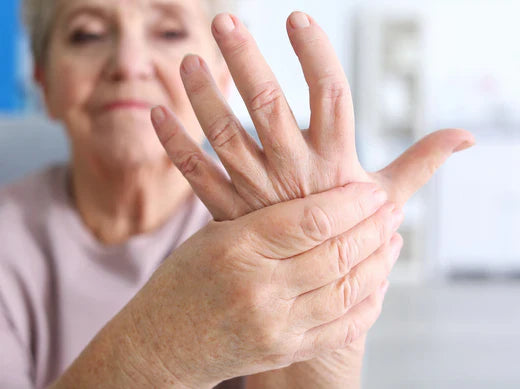Rheumatoid Arthritis (RA)
Rheumatoid Arthritis (RA)
Rheumatoid arthritis (RA) and osteoporosis are two separate medical conditions that often coexist in individuals. RA is a chronic autoimmune disease involving inflammation of the tissue around joints, which causes surrounding cartilage to wear down and subsequent bone loss around the affected joint. RA, like osteoporosis, commonly affects older adults. Women are two to three times more likely to develop RA than men. Swelling, stiffness, pain, and immobility affect people with rheumatoid arthritis, making it profoundly difficult for individuals living with RA to perform daily tasks. RA can lead to permanent joint damage if left untreated.
Since RA accelerates bone loss, RA is a known risk factor for osteoporosis, and people with RA are significantly more likely to experience a fragility fracture. While RA and osteoporosis are distinct conditions, there is some interaction between them. Rheumatoid arthritis can affect osteoporosis in the following ways:
- Chronic inflammation: Persistent inflammation caused by RA can stimulate cells called osteoclasts, which are responsible for breaking down bone tissue. This excessive bone resorption can lead to more bone loss and increase the risk of osteoporosis.
- Medications: The treatment for rheumatoid arthritis often involves medications to manage inflammation and modify the immune response. Medications such as corticosteroids (e.g. prednisone) and certain disease-modifying antirheumatic drugs (DMARDs) can contribute to bone loss and increase the risk of osteoporosis if used for prolonged periods. These medications can prevent the formation of new bone and accelerate bone resorption. Bone loss is most rapid in the first three to six months of treatment, even at low doses (2.5 to 7.5 mg prednisone daily).

- Physical inactivity: Rheumatoid arthritis regularly causes joint pain, stiffness, and swelling, which can limit mobility and physical activity. Limited movement and lack of weight-bearing exercises can lead to decreased bone mineral density and increase the risk of osteoporosis. Inactivity also negatively affects muscle strength, which plays a critical role in maintaining bone health.
- Hormonal changes: Rheumatoid arthritis predominately affects women, and hormonal factors may contribute to both the development of the disease and osteoporosis. Estrogen deficiency, which occurs during menopause or in women with RA, can accelerate bone loss and increase the risk of osteoporosis.
- Shared risk factors: RA and osteoporosis share some common risk factors. These include age, smoking, excessive alcohol consumption, low body weight, family history, and certain genetic predispositions. The presence of rheumatoid arthritis may exacerbate these risk factors, further increasing the likelihood of developing osteoporosis.
Strategies for proactively protecting your bone health and treating both RA as well as osteoporosis are as follows:
- Early detection and treatment: Identifying and treating RA as soon as possible is your best strategy for preventing osteoporosis. A simple blood test measuring inflammation is used to diagnose RA. Early treatment options have shown to effectively reduce inflammation and progressive bone loss. Certain antibodies and cytostatic drugs can block cytokines and protect bone health. Talk to your doctor about what treatment options are best suited for your particular condition.
- Monitor your bone health: Ask your doctor to perform a FRAX® or DXA (dual-energy X-ray Absorptiometry) scan to measure your bone mineral density, especially if you have been diagnosed with rheumatoid arthritis, have a family history of osteoporosis, or had a prior fracture. Read more about diagnosing osteoporosis here.
- Nutrition and lifestyle: Maintaining a balanced diet rich in calcium, vitamin D and protein is particularly important for your bone health. Regular exercise and a healthy bodyweight will further benefit your bones. Avoiding smoking will reduce your risk of developing osteoporosis and RA. Read more about maintaining healthy nutrition and an active lifestyle here.
- Fall prevention: If you have weak bones and have been diagnosed with rheumatoid arthritis, fractures can easily occur even after minor falls or slips. Remove trip hazards in your home and wear sturdy, slip-proof shoes. More fall prevention strategies can be found here.
Flexible hip protection will also give you peace of mind in the event of a fall. Phoenix Hipwear offers a light and comfortable memory foam shield to wear beneath your clothing undetected as you go about your day. Measure your hips today to get started!
It’s important to work closely with your healthcare provider to determine the most appropriate treatment plan for your specific condition and medical history. Please reach out to your medical provider to develop an osteoporosis and RA treatment plan that works best for you. For more information about hip protection and how Phoenix Hipwear can help you maintain your independence as you navigate rheumatoid arthritis and osteoporosis, contact us today to discuss your personal situation and work through next steps!

